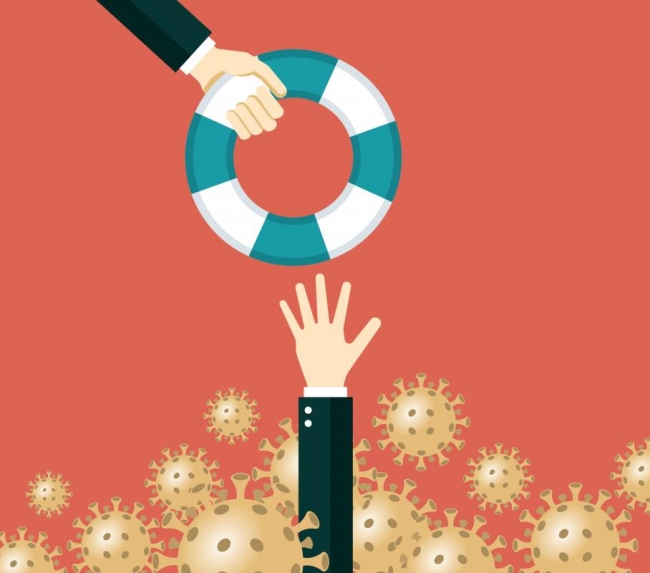You have /5 articles left.
Sign up for a free account or log in.

sorbetto/digitalvision vectors/getty images
Earlier this spring after I was fully vaccinated, I met two colleagues outdoors for lunch. It was a rare event, considering I had spent nearly a year being physically distant from most people.
My child had engaged in virtual school while I was telecommuting from home. We had cooked or eaten takeout instead of dining out. We had entertained ourselves with streaming services and hadn’t gone to the theater. I hadn’t hugged my parents or had the chance to even be in the same state as them for well over a year.
And so, on this bright, sunny Southern California day, when my colleague smiled at me and reached out for a friendly hug, I responded in kind. I hadn’t rehearsed this in my mind. I didn’t have a plan about whether I was going to hug back; I was happy to see her and instinct just quickly kicked in.
I found myself suddenly blurting out, “I haven’t hugged anybody other than the people in my own house for a year! I wasn’t ready!” We laughed about how awkward in-person interactions now were, and I realized that, although I had given lots of thought to how to gracefully bow out of social invitations from the comfort of my home, I hadn’t thought much about how to set social boundaries when I physically returned to campus -- particularly around optional activities and casual encounters. What would I do if someone came up to the threshold of my office unmasked and wanted to chat?
Of course, that happened several months later, during the tiny summer window when masks were not mandated, and as someone who carries more risk of COVID-19 complications than the average adult, I had a small moment of discomfort then. If social distancing in elevators is no longer required, what should you do when a large group of strangers gets on your elevator as it descends and you just aren’t comfortable?
Now, as we begin a new academic year, I’m asking about how to navigate the anxiety of our new workplace, one that, as it turns out, is not, and may not soon be, free from COVID-19. Note that I’m not asking about air filtration systems or about hand sanitizers. I’m not asking about the risk of transmission. I’m saying that anxiety, no matter how baseless it may seem to others, is something that humans carry. Some carry it gracefully and some carry it awkwardly, but this anxiety about our return to the physical campus cannot be quelled merely by handing employees a mask branded with a university logo.
I would argue that this anxiety is normal, that occasional awkwardness and uncertainty are normal, and we all need a little bit of compassion from our institutions and from each other to move with and through it. We all need a little help here, regardless of how long our campuses have been open or where we are in the term.
For many of us, this will be the first time in a year and a half that our quads are full of students and our housing facilities will be at capacity. Dining halls will ring with the sounds of gregarious students, many of whom will be experiencing college for the first time and who will be eager to socialize. This may be the first time in a long while that classes haven’t been predominantly virtual, and we’ll probably experience a lot of excitement about that. This may also be the first time in a long while that many of our colleagues will be faced with the juxtaposition of that warm campus “welcome back” feeling with fears of passing COVID-19 on to the unvaccinated children or elderly parents with whom they live. All of these feelings can be valid and true and can exist within the same person at the same time.
What are we telling each other about how to prepare for such feelings? How should you prepare for your own -- or somebody else’s -- anxiety when it inevitably arises this fall? Underneath some of the anxiety surrounding these casual social dilemmas lie real concerns about being the “difficult” or “noncollegial” co-worker. That has implications for tenure, merit increases and promotions, of course, and we all probably have some idea about who may be the most vulnerable. The people with medical conditions who may already face discrimination in the workplace, parents with young children who are often already erroneously perceived as too distracted to be serious scholars and employees, and people who have caregiving responsibilities for elders might be the very individuals who will experience the most dissonance about how to engage with their colleagues at work. What are you doing for them, how are you speaking to them and what kinds of community care and consent practices are you developing?
Each of our campuses has probably sent lots of email messages about getting back to work and about the policies and procedures that will govern compliance with various campus mandates (if there are any). Maybe there’s even been a town hall meeting. But what conversations is yours having about the anxiety and grief so many people are feeling right now?
Beyond Policies and Procedures
Let’s be clear: most of us already understand that we are expected back on our campuses. Some may be on campus more frequently than others, depending on their position and role. People will read those email messages about policies and procedures. What they probably haven’t read, though, is a thoughtful line or two from their supervisor about how hard this is going to be for some people. They probably haven’t heard that preparing for how they will interact with each other with care, consent and kindness is a good idea. They probably haven’t heard that they might mess up and be inelegant once or twice, and that it’s OK. They probably haven’t heard that other people might be just as scared as they are, and that the campus will weather the uncertainty, not with toxic positivity and hand sanitizer, but with compassion.
I suspect that some of the institutional communications surrounding the upcoming semester or quarter have been focused on how to “return to work.” Show of hands: How many of us have returned to anything resembling what we knew in March of 2020? How many of us have lost a colleague to COVID-19 or had to deal with myriad other challenges surrounding the pandemic during these past 18 months? Some folks have been downsized or laid off. Some have left higher ed entirely for careers outside higher education or for more flexible situations that allow for more telecommuting and work-life integration.
Your office may look the same. Dust may have collected over piles of paper and may have seemingly frozen everything in time, but things are not the same. The new crop of students has been through a global pandemic. Some of your colleagues are scared. Some of your colleagues, especially those in health care, are tired. Returning to life as it was before the pandemic just isn’t realistic.
If your institution has been open, you know. If it has been largely physically closed, you’ll soon find out. And what people are hoping to see from senior administrators and from each other is an acknowledgment that something new needs to be forged from both the joys and sorrows of this past year.
My hope is that we start the new academic year with an acknowledgment that we need more than just emails about cleaning practices, campus policies and where to get tested. My hope is that campus messages are not designed to bypass concerns, criticisms, trepidation or negative feelings. That should not be the goal.
The goal is to recognize that this is, in many ways, an exciting as well as a scary new chapter for us all -- that both things can be true at the same time. It is to acknowledge our shared humanity, the presence of negative feelings right alongside the positive ones and how hope can buoy us as we engage science, empathy, compassion and wisdom.








